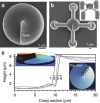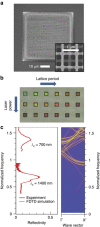Ultrafast laser processing of materials: from science to industry
- PMID: 30167182
- PMCID: PMC5987357
- DOI: 10.1038/lsa.2016.133
Ultrafast laser processing of materials: from science to industry
Abstract
Processing of materials by ultrashort laser pulses has evolved significantly over the last decade and is starting to reveal its scientific, technological and industrial potential. In ultrafast laser manufacturing, optical energy of tightly focused femtosecond or picosecond laser pulses can be delivered to precisely defined positions in the bulk of materials via two-/multi-photon excitation on a timescale much faster than thermal energy exchange between photoexcited electrons and lattice ions. Control of photo-ionization and thermal processes with the highest precision, inducing local photomodification in sub-100-nm-sized regions has been achieved. State-of-the-art ultrashort laser processing techniques exploit high 0.1-1 μm spatial resolution and almost unrestricted three-dimensional structuring capability. Adjustable pulse duration, spatiotemporal chirp, phase front tilt and polarization allow control of photomodification via uniquely wide parameter space. Mature opto-electrical/mechanical technologies have enabled laser processing speeds approaching meters-per-second, leading to a fast lab-to-fab transfer. The key aspects and latest achievements are reviewed with an emphasis on the fundamental relation between spatial resolution and total fabrication throughput. Emerging biomedical applications implementing micrometer feature precision over centimeter-scale scaffolds and photonic wire bonding in telecommunications are highlighted.
Keywords: 3D structuring; biomedical applications; direct laser writing; functional microdevices; material processing; nonlinear light–matter interaction; ultrashort laser pulses.
Figures












References
-
- Davis KM, Miura K, Sugimoto N, Hirao K. Writing waveguides in glass with a femtosecond laser. Opt Lett 1996; 21: 1729–1731. - PubMed
-
- Maruo S, Nakamura O, Kawata S. Three-dimensional microfabrication with two-photon-absorbed photopolymerization. Opt Lett 1997; 22: 132–134. - PubMed
-
- Kawata S, Sun HB, Tanaka T, Takada K. Finer features for functional microdevices. Nature 2001; 412: 697–698. - PubMed
-
- Glezer EN, Milosavljevic M, Huang L, Finlay RJ, Her TH et al. Three-dimensional optical storage inside transparent materials. Opt Lett 1996; 21: 2023–2025. - PubMed
-
- Watanabe M, Sun HB, Juodkazis S, Takahashi T, Matsuo S et al. Three-dimensional optical data storage in vitreous silica. Jpn J Appl Phys 1998; 37: L1527–L1530.
Publication types
LinkOut - more resources
Full Text Sources
Other Literature Sources
Miscellaneous

